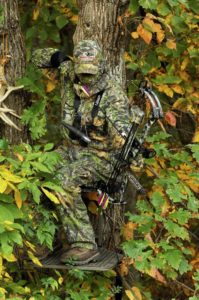 To reduce hand pressure and torque that can throw arrows off line, hold your bow with a relaxed, open palm grip. When you relax your bow-holding hand your entire body tends to follow suit and loosen up, which makes you shoot more accurately.
To reduce hand pressure and torque that can throw arrows off line, hold your bow with a relaxed, open palm grip. When you relax your bow-holding hand your entire body tends to follow suit and loosen up, which makes you shoot more accurately.
- Screw broadheads into the 5 arrows you’ll carry in your hunting quiver. Shoot every arrow into a broadhead. You’ll find that 2 or 3 of those arrows fly truer than the rest, especially if you still use fixed heads. Mark those shafts 1,2 and 3. Those should be the first ones you hunt with.
- Is your peep sight right? To find out, clip your release to the string, close your eyes, draw your bow and anchor. Open your eyes. You should be able to see sight pins clearly through the peephole without moving your face, anchor point or bow. If not, let down and adjust the peep slightly up or down.
- For afternoon hunting in early season, lock a stand on a tree so that it faces a crop field, acorns or other food source. Most deer will come from the woods and thickets to the rear; the tree between you and them will provide good cover. Make sure the wind is not blowing back in cover where a buck is likely to come from.
- If you shoot a bow right-handed, set up where deer will pass within 30 yards to your left (vice versa for southpaws). You can draw and shoot with ease and little movement as a buck quarters past.
- With leaves still thick on the trees in early season, you might be able to see and shoot best by hunting only 15/16 feet high. Be doubly sure the wind is right and steady when you hunt low. After the leaves fall, readjust and hunt higher and above the sight plane of bucks.
- Trim 3 or 4 shooting lanes to the sides and front of your stand. Drag trimmed limbs and saplings away from your stand so deer won’t see or smell them.
- I prefer arrows fletched with white or bright-yellow vanes. I find that as you shoot a deer and follow through, your eyes will instinctively follow the white or yellow blur; watch the vanes disappear into a buck and you’ll know how good the shot was.
- After the shot, check the arrow and vanes that passed through a deer. Red blood with pink bubbles (lung hit, good); dark, thick blood (liver, marginal and wait several hours before tracking); green, watery matter (stomach) is easy to see and decipher on white or yellow vanes. On a dreaded gut shot, wait at least 6 hours before looking for the animal.






Love your show!
I like that you’re a practical hunter! You harvest what you feel like taking big or small you still consider it trophy! I’m the same way that’s probably why I enjoy watching you hunt we’re about the same age and have been hunting with friends and family since the 1960’s and aside from family it’s my life.
I hunt New York,Pensylvania and New Jersey
And opening Day Is approaching quickly!
Looking forward to watching your show and online Rut predictions
Best wishes, Charlie Thompson